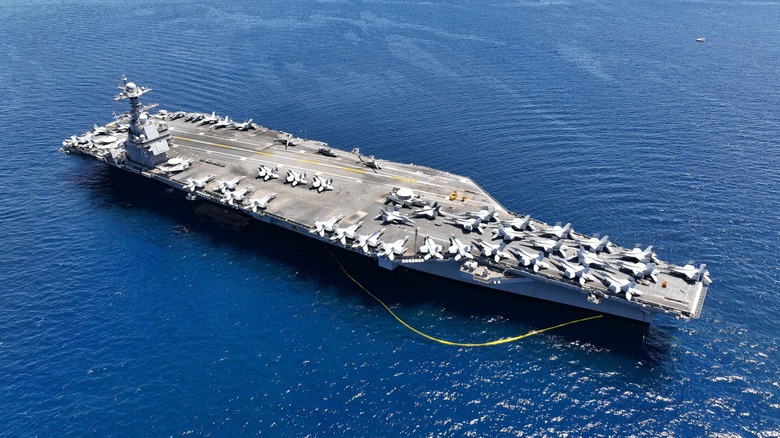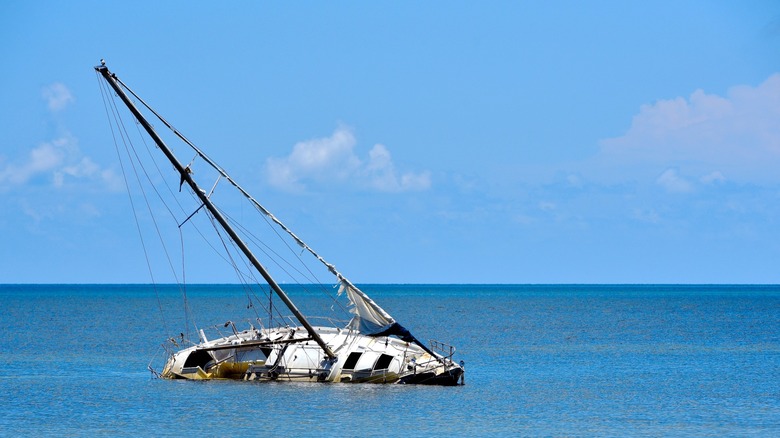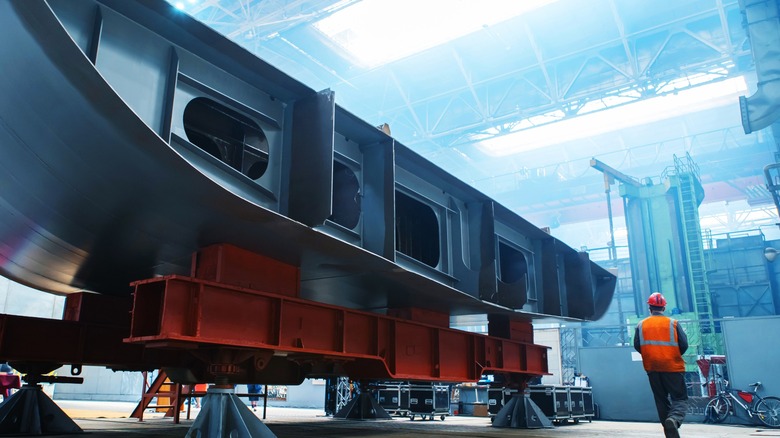Here's How Massive Navy Ships Actually Float
We live in a marvelous time. Above us, metal vessels soar 30,000 feet high, cutting through clouds and turbulent air at hundreds of miles per hour. In the ocean, massive structures glide across the surface like some religious miracle.
Navy vessels are huge, with one of the biggest ships the world has ever seen, the USS Gerald R. Ford, coming in at just over 1,100 feet long. (For reference, the Empire State Building's top floor is 1,250 feet tall.) In terms of weight, this behemoth clocks in at 90,000 tons.
So, how does a ship that's as big as a skyscraper and heavier than practically any on-land vehicle remain afloat? After all, the heavier something is, the faster it's going to fall to the ocean floor, right? Contrary to what seems like sound logic, huge ships like aircraft carriers are actually quite hard to sink. However, to fully understand how such a huge ship can float, we'll need to break out some surprisingly elementary science involving volume, displacement, and buoyancy before extrapolating it to a much larger proportion.
What keeps anything afloat in water?
While it's quite impressive that the USS Gerald R. Ford can cut through water like magic, the same principles keeping that striking aircraft carrier mostly above water can be applied to something much smaller, like a speed boat.
There are two primary factors that determine whether a boat will sink or float: gravity and density. Gravity is a constant on Earth. Though it has a much bigger role in the universe, on a small scale, it keeps us from floating out into the atmosphere when we jump. Since the ground is a solid, gravity has a limit to how much it can pull us down. However, water is a different story.
The reason why we're able to float on our backs in water can be attributed to a force known as buoyancy, which is, in effect, gravity acting upon the object with the highest density. Generally speaking, a high-density object will sink as it's more dense than water. When applied to the Nimitz-class carrier, that doesn't make sense, though, right? How could a 90,000-ton object be lighter than water? The reality is that if that weight occupied a smaller space, it wouldn't stay afloat so effortlessly.
It's all in the design
If you were to drop a 10-pound steel ball and a 10-pound sheet of steel into a pool of water, the ball would sink almost immediately while the sheet could remain afloat. That's because the density of the ball is focused on a small area while the sheet distributes its weight, causing it to displace more water than the ball.
The more water an object displaces, the stronger the upward thrust it experiences. This upthrust works against the gravitational pull, creating a buoyancy that keeps the sheet of metal floating on the surface. If you unevenly add weight, you'll cause parts of the sheet to become more dense than the water and sink.
Naval vessels are technological marvels, and the science behind them is delicate. Engineers need to consider gravitational pull, object density, and upward thrust. A vessel designed to carry a lot of weight, like a cargo ship, must be carefully designed with a greater displacement of water in mind. This way, the upthrust can be greater to keep the vessel afloat. The USS Gerald R. Ford displaces a whopping 100,000 tons, meaning there is plenty of upward thrust to keep it above water.
What keeps boats from capsizing?
When you think of water, stability is probably not the first thing that comes to mind. If you've ever stepped foot on a small boat, you've probably experienced it rocking or tipping, especially as you try to board. If that boat tips too much to one side, it's at risk of capsizing. This is all because a boat's center of gravity can be thrown off. Before any additional weight is added to the boat, its center of gravity lies at the lowest center point of the vessel, but once you step on, you add weight and shift its center of gravity.
Since some components on a Navy vessel can be quite large, you'd expect them to have the same problem. However, these ships are designed to have a lower center of gravity. Some of the heaviest aspects of a Navy vessel, like the engines, are located deep within the hull, keeping them stable and balanced against the weight of its cargo.
Additionally, ships like the USS Gerald R. Ford are designed with a large keel. This serves as the ship's backbone, running lengthwise through the boat before the water line to make rolling or capsizing more difficult. This is how these massive ships can withstand larger waves and big storms without being lost at sea.



